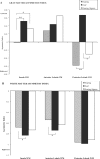Morphology of the insula in relation to hearing status and sign language experience
- PMID: 19005055
- PMCID: PMC2606108
- DOI: 10.1523/JNEUROSCI.3141-08.2008
Morphology of the insula in relation to hearing status and sign language experience
Abstract
We investigated whether auditory deprivation and/or sign language exposure during development alters the macroscopic neuroanatomy of the human insula. Volumetric analyses were based on MRI data from 25 congenitally deaf subjects who were native users of American Sign Language (ASL), 25 hearing subjects with no knowledge of ASL, and 16 hearing subjects who grew up in deaf families and were native ASL signers. Significant variation in insula volume was associated with both hearing status and sign language experience. Compared with both hearing groups, deaf subjects exhibited a significant increase in the amount of gray matter in the left posterior insular lobule, which we hypothesize may be related to the dependence on lip-reading and articulatory-based (rather than auditory-based) representations of speech for deaf individuals. Both deaf and hearing signers exhibited an increased volume of white matter in the right insula compared with hearing nonsigners. We hypothesize that the distinct morphology of the right insula for ASL signers may arise from enhanced connectivity resulting from an increased reliance on cross-modal sensory integration in sign language compared with spoken language.
Figures



Similar articles
-
Neural systems underlying British Sign Language and audio-visual English processing in native users.Brain. 2002 Jul;125(Pt 7):1583-93. doi: 10.1093/brain/awf153. Brain. 2002. PMID: 12077007 Clinical Trial.
-
Cross-modal integration and plastic changes revealed by lip movement, random-dot motion and sign languages in the hearing and deaf.Cereb Cortex. 2005 Aug;15(8):1113-22. doi: 10.1093/cercor/bhh210. Epub 2004 Nov 24. Cereb Cortex. 2005. PMID: 15563723
-
The impact of early language exposure on the neural system supporting language in deaf and hearing adults.Neuroimage. 2020 Apr 1;209:116411. doi: 10.1016/j.neuroimage.2019.116411. Epub 2019 Dec 16. Neuroimage. 2020. PMID: 31857205 Free PMC article.
-
Human brain plasticity: evidence from sensory deprivation and altered language experience.Prog Brain Res. 2002;138:177-88. doi: 10.1016/S0079-6123(02)38078-6. Prog Brain Res. 2002. PMID: 12432770 Review.
-
The bimodal bilingual brain: effects of sign language experience.Brain Lang. 2009 May-Jun;109(2-3):124-32. doi: 10.1016/j.bandl.2008.03.005. Epub 2008 May 8. Brain Lang. 2009. PMID: 18471869 Free PMC article. Review.
Cited by
-
How bilingualism protects the brain from aging: Insights from bimodal bilinguals.Hum Brain Mapp. 2017 Aug;38(8):4109-4124. doi: 10.1002/hbm.23652. Epub 2017 May 17. Hum Brain Mapp. 2017. PMID: 28513102 Free PMC article.
-
Associations between Family Adversity and Brain Volume in Adolescence: Manual vs. Automated Brain Segmentation Yields Different Results.Front Neurosci. 2016 Sep 5;10:398. doi: 10.3389/fnins.2016.00398. eCollection 2016. Front Neurosci. 2016. PMID: 27656121 Free PMC article.
-
Brain Morphological Modifications in Congenital and Acquired Auditory Deprivation: A Systematic Review and Coordinate-Based Meta-Analysis.Front Neurosci. 2022 Mar 28;16:850245. doi: 10.3389/fnins.2022.850245. eCollection 2022. Front Neurosci. 2022. PMID: 35418829 Free PMC article.
-
The neural circuits recruited for the production of signs and fingerspelled words.Brain Lang. 2016 Sep;160:30-41. doi: 10.1016/j.bandl.2016.07.003. Epub 2016 Jul 25. Brain Lang. 2016. PMID: 27459390 Free PMC article.
-
Psycholinguistic, cognitive, and neural implications of bimodal bilingualism.Biling (Camb Engl). 2016 Mar;19(2):223-242. doi: 10.1017/S1366728915000085. Epub 2015 Apr 23. Biling (Camb Engl). 2016. PMID: 28804269 Free PMC article.
References
-
- Ackermann H, Riecker A. The contribution of the insula to motor aspects of speech production: A review and a hypothesis. Brain Lang. 2004;89:320–328. - PubMed
-
- Allen JS, Damasio H, Grabowski TJ, Bruss J, Zhang W. Sexual dimorphism and asymmetries in the gray-white composition of the human cerebrum. Neuroimage. 2003;18:880–894. - PubMed
-
- Allen JS, Bruss J, Brown CK, Damasio H. Normal neuroanatomical variation due to age: the major lobes and a parcellation of the temporal lobe. Neurobiol Aging. 2005a;26:1245–1260. discussion 1279–1282. - PubMed
-
- Allen JS, Bruss J, Brown CK, Damasio H. Methods for studying the aging brain: volumetric analyses versus VBM. Neurobiol Aging. 2005b;26:1275–1278.
-
- Augustine JR. Circuitry and functional aspects of the insular lobe in primates including humans. Brain Res Brain Res Rev. 1996;22:229–244. - PubMed
Publication types
MeSH terms
Grants and funding
LinkOut - more resources
Full Text Sources
Medical
